
This week marks the 40th anniversary of the Watts Uprising in Los Angeles. Today, many of the same economic inequalities persist for African American residents of South Central. We speak with Gerald Horne, author of “Fire This Time: The Watts Uprising and the 1960s.” [includes rush transcript]
This week marks the fortieth anniversary of the Watts rebellion. Forty years ago yesterday, the South Central neighborhood of Watts, Los Angeles erupted into six days of rioting after white traffic police stopped a black man, accused him of drunk driving and crowds gathered as officers began beating him with their batons. The Watts uprising sheparded in a new more militant era of the civil rights movement as African-Americans took to the streets in a mass protest against white economic exploitation and police brutality.
But mainstream media coverage at the time portrayed the uprising only as lawless and destructive. There was little attempt to understand the reasons behind the rebellion and there were virtually no interviews with the rioters themselves. In fact, at the time of the riots, the L.A Times did not have one black reporter on its’ staff.
- Universal Newsreel, report on the Watts Riots, 1965
That was a Universal Newsreel report from 1965 about the Watts rebellion. We now go to a radio documentary from the Pacifica Radio Archives about the uprising that was also produced in 1965. It is entitled “The Fire This Time” and was produced by Pacifica Radio”s KPFA and KPFK.
- “The Fire This Time”, radio documentary produced by Pacifica Radio’s KPFA and KPFK in 1965. Pacifica Radio Archives
- Gerald Horne, author of the book “Fire This Time: The Watts Uprising and the 1960s”
Transcript
JUAN GONZALEZ: We go now to a news report from that era.
NEWSREEL: Six days of rioting in a Negro section of Los Angeles left behind scenes reminiscent of war-torn cities. More than a hundred square blocks were decimated by fires and looters, and few buildings were left intact. Firemen were [inaudible] snipers and brick-throwing hoodlums as they attempted to control the fires, many of which were left to burn themselves out. As the national guard moved in to restore comparative calm, the losses by fire alone were put at $200 million. No attempt has yet been made to estimate the losses suffered at the hands of the looters who stole everything from liquor to playpens.
Firemen were later issued flak suits of bulletproof mesh to protect them from snipers who continued to shoot from rooftops. Nearly 3,000 were arrested and authorities had to open abandoned jails to house those netted by the police. It took the appearance of 14,000 troops to bring an end to what both Negro and white leaders called “insurrection by hoodlums.” Civil rights leaders were quick to deplore the unbridled lawlessness, and Martin Luther King vowed to do all in his power to prevent a recurrence in Los Angeles or anywhere.
An uneasy calm prevails in what is known as the Watts area of the city. A curfew was put into effect and the entire section declared off limits to all but residents. The people who live here are suffering great hardship, with no grocery, drug or other service stores able to operate.
A special task force of 1,000 policemen stays on the alert as the thousands of guardsmen patrol an area of 35 square miles. The outbreaks spread to other Southern California cities but were quickly quelled, and Los Angeles authorities say they are now ready to move with dispatch if lawlessness breaks out anew. The riots in Los Angeles have written a sorrowful page in American history.
AMY GOODMAN: That was a Universal Newsreel report from 1965 about the Watts rebellion. We now go to a Pacifica documentary called about the uprising that was also produced then, entitled “The Fire This Time,” produced by stations KPFA and KPFK.
UNIDENTIFIED MAN 1: The chief of police, I had seen him on television these last few days trying to blame the whole thing on agitators. Parker said, 'Well, agitators had been going into that neighborhood for two years and telling those people they're deprived, and so naturally they’re beginning to believe them.’ My god, does he really believe these people are so stupid that they don’t know they’re deprived until agitators tell them so?
UNIDENTIFIED MAN 2: If you look at the TV and the radio coverage, if you look at the newspaper coverage of this event, the entire press coverage with almost no exception is white. Here, we’re talking on TV, where we look at face after face after face, covering this Negro revolt, and there isn’t a Negro face discussing it. We get this all filtered through white minds, white thinking, white experience, white relationships, and let’s face it, the most important fact, white fears, white fears of the Negro, of what the Negro will do, of where the Negro will move and, of course, always in the back of everybody’s mind, 'would you like one to marry your daughter?' And let’s not forget this. This is the big ridiculous bugaboo, the fetish.
UNIDENTIFIED WOMAN 1: Now, look, a white man in Mississippi will go with a colored woman. But you let a colored man — look how they did poor Emmett Till. He whistled at a low class white woman, they say. And they found him, and he was dead. And he wasn’t but 15 years old. If a white man can go with a colored woman, why can’t a colored man go with a white woman? She ain’t no better than us. That’s right.
UNIDENTIFIED WOMAN 2: We are born equal. At least many of us believe that we are born equal. But yet, the Negro is expected to behave in a superior manner. Remember the churches were bombed. The news media brought it to our teenagers, young children were killed in a church at Sunday school. The snipers killed Medgar Evers. Now when snipers are shooting, you know, it’s wrong. But yet the Negro is supposed to behave in a superior manner and supposed to see the difference. Hoses and dogs were turned on the people in Alabama. But yet, we are supposed to live with this and have no feelings about it and at no time show any resentment.
UNIDENTIFIED MAN 3: All I got to say is “Burn, whites! Burn the mother!”
UNIDENTIFIED WOMAN 1: You can’t even get a job around here, not a decent job. Alright, they hired my mother as a cook. She cooked for a white woman almost 15 years, but yet, still she’s not good enough to come through the front door. Go through the backdoor. She had to do it because she had us to take care of. That’s right, I’d be willing to live next door hand in hand with the white man. That’s right, if they treat us just like we’re supposed to be treated, like we’re human and not dogs.
UNIDENTIFIED MAN 2: There was a great deal of destruction of property, great deal of rock throwing, great deal of bottle throwing, great deal of Molotov cocktail throwing. There was some very professional arson done out there that I saw firsthand. But there were relatively few people killed, and most of them, I think almost 10 to one, that the people killed were colored. Now these people are armed out there in the ghetto. They have certainly an adequate number of firearms, they have adequate ammunition, they looted scores of pawn shops in order to get these guns, sporting goods stores, war surplus stores. They have hunting rifles, they have their own pistols. Why was it that so few people got killed on the side of the police? This strikes me as being a violent protest, but not necessarily a murderous insurrection, because the casualties don’t look right.
UNIDENTIFIED WOMAN 2: We wonder how the normal deprived person reacts when you’re hungry, you’re overcrowded, you have no hope. Some people commit suicide. Others must learn how to handle it and must not show it in any way. They must be patient. They must wait. How much can you be deprived?
UNIDENTIFIED MAN 4: You start in Alhambra and go through Los Angeles and drive straight down Mission, you’ll run through a Mexican neighborhood for ten miles and when you leave that Mexican neighborhood, you run into a colored neighborhood and you stay in that colored neighborhood until you get out of the city of Los Angeles. You can drive 20 miles. And the white people have abdicated the central part of Los Angeles to Negros and Mexicans. There are a million and a half of them. And there is no race riot, because if there were a race riot, they would burn down the city of Los Angeles.
UNIDENTIFIED MAN 5: How come they can’t do to us like they do to the whites? How come they can’t do to us like they do to the whites?
UNIDENTIFIED MAN 6: It’s not only the police department, man! It’s every other —
UNIDENTIFIED MAN 5: It’s the police department!
UNIDENTIFIED MAN 7: I said last year, this was going to happen. Everybody said I was an alarmist. But I said that if the police continued in their course of behavior, we were going to have exactly this event. The only problem was when.
UNIDENTIFIED MAN 8: The intersection is littered with debris from glass, from accidents, cars that have been abandoned and gutted by fire, lying at intersections. I seen a complete and utter panemonium, spreading faster and faster throughout the ghetto.
AMY GOODMAN: Pacifica documentary on the Watts uprising, as we turn now to Gerald Horne, author of the book, Fire This Time: The Watts Uprising and the 1960s. Juan?
JUAN GONZALEZ: Gerald, welcome, and your thoughts 40 years later?
GERALD HORNE: Sadly and unfortunately, Juan, some of the causes of that civil unrest of 1965 are still with us. First of all, the industrialization, offshoring, the slaying of jobs which leads to despair, that’s still with us. Police misconduct, police brutality, that was what lit the fuse in 1965, I’m afraid that’s still with us, as well. So as we go into the 21st century, I’m afraid, 40 years later, after August 1965, the basic conditions that led to the then largest episode of unrest in this country to that time, those causes are still with us.
AMY GOODMAN: You wrote a whole book, Fire This Time, Gerald Horne. What captivated you about — what did you find was most important about the Watts uprising?
GERALD HORNE: Well, in part it was the ideology that came out of those events. That is to say, August 1965 was a hinge moment in terms of U.S. history. With August 1965, you see the efflorescence, you see the rise of a certain kind of masculinous black nationalism. You also see the rise of a certain kind of activism — it’s from August 1965, those ashes that you see the rise of the Black Panther Party, an organization which, of course, was emulated all across the globe. It’s with August 1965, I’m afraid, as well, you see the rise of a pattern mass incarceration. Note that in that documentary you just broadcast, they talked about how they felt they had a dirth of jails. And it was with that particular moment that you see this expansion of what has now come to be known as the prison industrial complex, which, of course, has led to the incarceration of a generation of African American males. In particular, now, it’s sweeping within its gambit African American women.
AMY GOODMAN: Gerald Horne, I want to thank you very much for being with us, author of Fire This Time: The Watts Uprising and the 1960s.

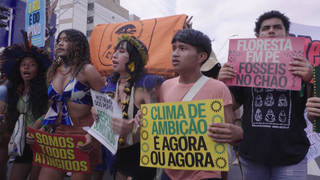
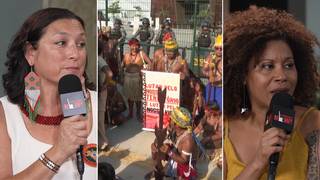
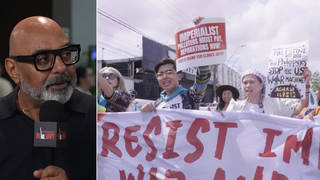






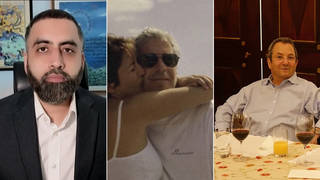
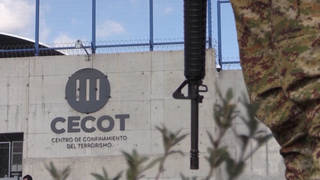
Media Options